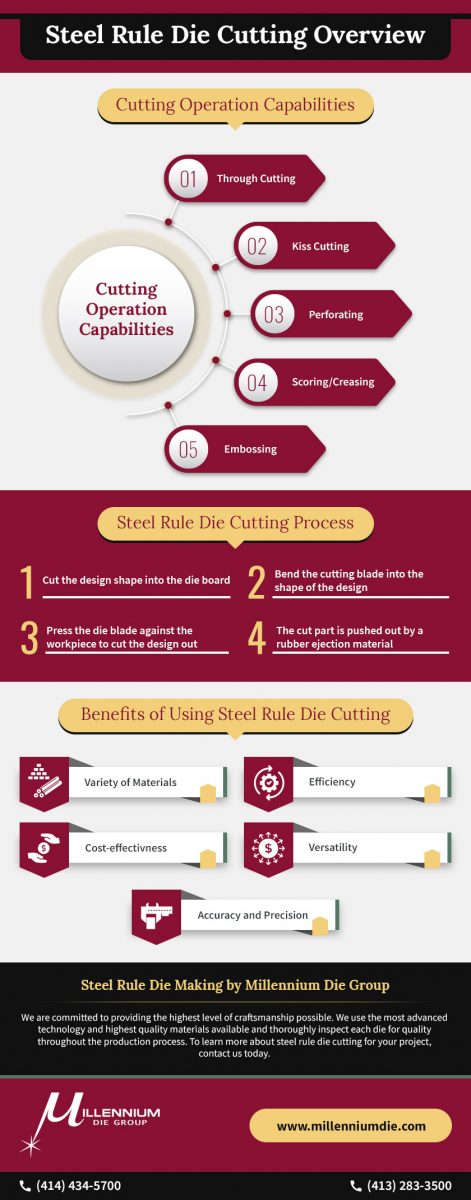Steel Rule Die Cutting Overview
Die cutting is a converting process that turns stock material into a specific shape or pattern. It uses specialized machinery and equipment to cut, form, and shape a variety of materials. Steel rule dies specifically are an economical and versatile method for converting soft and semi-rigid materials in two dimensions.
At Millennium Die Group, we employ state-of-the-art equipment and rigorous quality control procedures to meet the most precise tooling requirements. We provide consultation and engineering services to tailor the die design to our customers’ specific needs. The latest technology available is used to create precision steel rule dies for a variety of industries.
What is Steel Rule Die Cutting?
Steel rule die cutting is a type of die cutting that manipulates the stock material by pressing a sharp steel rule (“knife”) down into the material against a flat surface. The cutting edge pierces the material being converted, separating the part and the waste. This 2-dimensional process is also often referred to as flatbed die cutting. While more complex, the process is comparable to using a cookie cutter to cut specific shapes out of cookie dough.
Steel rule die cutting is an effective method of mass producing uniform components at a low cost. It is used for many applications, including printed folders, greeting cards, folding cartons, gaskets, labels, control panels and overlays, membrane switches, and medical disposables, including PPE used for protection against COVID-19.
Benefits of Using Steel Rule Dies
Steel rule die cutting offers a variety of benefits. Some of these include:
- Variety of Materials. Steel rule die cutting can be used to transform a wide range of soft and semi-rigid materials.
- Efficiency. The process is an efficient, high-speed method of creating uniform products with high quality, clean, vertical edges.
- Cost-effectiveness. The tooling for steel rule die-cutting is inexpensive, features a short set-up time, and allows multiple dies to be nested and integrated into a single die board to reduce raw material waste. The customer can cut many pieces in a shorter period of time than is possible with other methods. Steel rule die-cutting offers an efficient and cost-effective solution for short to medium production runs.
- Versatility. The process can be used with thin or thick materials and is suitable for creating large or small parts. Steel rule die cutting produces minimal material deformation and can be used to kiss cut, allowing your die-cut parts to be delivered in rolls if needed. Dies may also be nested to create multiple cuts at once.
- Accuracy & Precision. Steel rule die cutting is a precise way to cut a material, which produces cuts that are the same each time, within a small margin of error.
Steel Rule Die Making Process
A steel rule die has three components: a die base (board), steel rule cutting blade, and rubber ejection material. The process for making a die looks like this:
- We consult with the customer to gather the required specifications.
- The design shape is cut into the die base using a laser cutter or water jet.
- The steel rule cutting blade is bent into the shape of the design, either by hand or with automated equipment, and fitted into the laser-cut channel in the die board.
- Full optical inspection is performed to ensure the cut edge parts that meet customer requirements.
- Finally, rubber or foam material is used to eject the waste material from the die-cut cavity and sometimes to add stability to the tool.
Die cutting offers several different cutting operation capabilities, including:
- Through cutting. This process cuts through the material completely. When slicing through laminates and adhesive-backed materials, for example, the die cuts through each layer to fully separate the part from the waste material.
- Kiss cutting. The material’s top layers are cut, but the backing material is left intact. Kiss cutting is often used when creating adhesive labels or stickers, as it cuts through paper and adhesive layers without piercing the backing material.
- Perforating. The cut edge of the rule is notched to produce specific lengths of cuts and gaps (“lands” and “grooves”). Spacing of the perforations can be created easily and accurately. This allows the part to be separated or folded at the weak points caused by the perforation.
- Creasing & scoring. These two processes create an impression or partial cut in the material to aid in the folding of three-dimensional shapes, such as boxes. Crease rule crushes the material without cutting, whereas scoring cuts partway through. In both cases, the material is weakened in order to increase the flexibility of the material in the intended area, allowing it to fold.
Materials Cut by Steel Rule Dies
Steel rule die-cutting is a simple, cost-efficient process that provides unmatched uniformity of the final product. The process creates clean, accurate cuts, and doesn’t warp or bend materials. At Millennium Die Group we create steel rule dies suitable for cutting a variety of materials including:
- Foam
- Paper
- Cardboard
- Rubber
- Plastic
- Cork
- Fiberglass
- Metal foil
Our dies can be used to cut a variety of plastics, including:
- Polyethylene Terephthalate (PETE)
- High-Density Polyethylene (HDPE)
- Vinyl/Polyvinyl Chloride (V/PVC)
- Low-Density Polyethylene (LDPE)
- Polypropylene (PP)
- Polystyrene (PS)
- NYLON Polyamide Plastic (PA)
- Acrylonitrile butadiene styrene (ABS)
- Polycarbonate (PC) – Lexan
- Acrylic
Steel Rule Die Making by Millennium Die Group
At Millennium Die Group, we utilize advanced Gerber Technology FastTrack laser systems driven by a 2,500-watt PRC turbo laser. Our CO2 lasers enable us to create precise kerf in a variety of die bases in a time-efficient manner. Along with our lasers, we use OMAX Corporation water jet technology to make dieboard out of aluminum, metals, and plastics. We work with our customers to create CAD-CAM solutions to die designs, meeting specific needs for the product. Further, we offer engineering and consulting services to make sure our customers get the result they are seeking. Our processes for making steel rule dies improve efficiency and save clients time and money.
We are committed to providing the highest level of craftsmanship possible. We use the most advanced technology and highest quality materials available and thoroughly inspect each die for quality throughout the production process. To learn more about steel rule die cutting for your project, contact us today.

